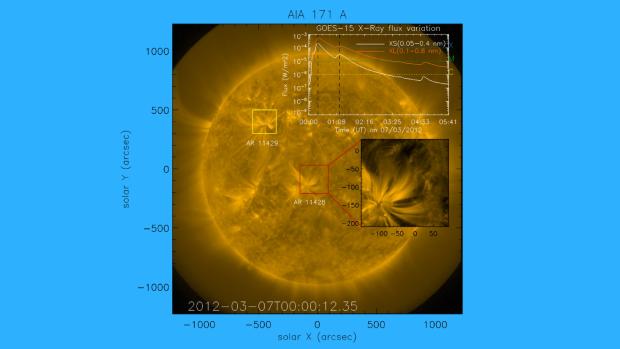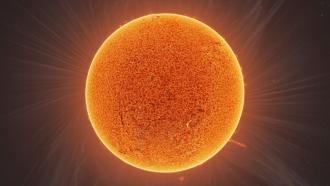
Photo: Pant et. al., 2017
The 7th of September, 2017 was unlike any other. The skies over some parts of the northern hemisphere were lit up with auroras. Radio communication devices snapped briefly and there was a widespread blackout in those parts that faced the Sun. The culprit? Solar flares -- an immense outburst of energy on the solar surface that sends out a deluge of high-energy particles out into space. Classified as a class X – the highest classification, this flare was the most powerful flare seen in over a decade, pouring out as much energy as would billions of hydrogen bombs.
Scientists have special interests in these Solar flares. “On the Sun, explosions happen when different magnetic field lines entangle and snap because of the constant motions happening in the atmosphere of the Sun. The snapping of the magnetic field lines releases a large amount of energy in a short interval of time. This phenomenon is called a solar flare, which in turn, sends shockwaves travelling on the surface of the Sun”, explains Vaibhav Pant, a PhD student at Indian Institute of Astrophysics (IIA), Bangalore.
In a recent study, Mr. Pant and a group of researchers from Northumbria University, Newcastle, UK and Harbin Institute of Technology, Shenzhen, China, have observed a never-before-seen phenomenon on the solar surface on March 6th 2012, which was triggered by another class X solar flare. For the first time, they had observed a ‘standing’ wave in the coronal structures of the Sun. In a paper published recently in The Astrophysical Journal, the researchers have proposed a mechanism for the origin of the ‘standing wave’ and have probed its properties.
The Sun’s corona is a cloud of plasma, or ionised gases, surrounding it. If you have ever seen a total solar eclipse, the corona is visible to the naked eye as a halo surrounding the Sun. It extends millions of kilometres into space from the surface of the Sun, reaching temperatures of 1 to 3 million Kelvin. There is much action in the corona. Influenced by the magnetic field of the Sun, many coronal structures are formed when the hot plasma follows the magnetic field lines, much like iron fillings forming patterns around a magnet. A coronal fan loop is one such coronal structure that spreads outwards and is narrow and dense at the surface of the Sun. It is a loop formed by plasma shaped by the immense magnetic field of the Sun, with the two ends tied to the surface of the star. Just like a string attached to a ball.
The events on March 6th, 2012 unfolded when a powerful flare was triggered in a region of high activity -- a region where sunspots and solar flares regularly occur -- named AR 11429. When the shock waves from this flare reached a coronal fan loop in another active region named AR 11428, it set off oscillations in the coronal structure, which led to the formation of a standing wave in the coronal fan loop.
“A wave is called standing wave, if the energy of the wave does not travel from one location to another. To make this happen, there should be a reflection of energy from somewhere”, remarks Mr. Pant. This is similar to exciting a guitar string tied at two ends by plucking it. Once excited, the wave travels from one end to the other, getting reflected each time it hits the tied ends, and eventually forms a standing wave on the string. “Same thing happens in the coronal structures, called coronal loops, where the ends of the loop are tied to the solar surface”, he adds.
The standing waves so observed is a treasure trove of information, say scientists. “A wave carries the information of the medium in which they travel. For example, the speed of a sound wave depends on the pressure and density of the medium in which the sound wave propagates. Similarly, the study of these compressive waves helps us understand different properties of the medium through which they travel, which is plasma in this case. Since the observed standing waves were seen in coronal loops, they carry information about plasma confined in the coronal loops”, explains Mr. Pant.
The study also revealed that the standing wave reflected much before the location where the fan loop is tied to the solar surface. This phenomenon is unlike a wave on the guitar string where it is reflected at the point where the string is tied. The scientists theorize this may be a result of the sharp change in density of plasma along the fan loop, which causes the wave to turn back before it reaches the ends close to the solar surface.
The scientists are now looking to conduct seismological measurements to estimate the physical properties, like density and temperature, of the plasma. This could lead to better computer models that can accurately portray the properties of the plasma and the fury of the solar flare.






